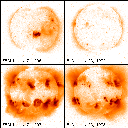Global connectivity
Science nugget: July 18, 1998
Background
This is a retrospective on studies arising from mid-1996. Recall that this
was near solar minimum, but that one side of the Sun showed an activity
complex including the "last best AR" of the old cycle, AR7978. The figure
below shows graphically how the population of active regions has changed
in the last couple of years:

The occurrence of newly emerging flux in an otherwise unperturbed corona
allows us to study the interconnections with less confusion. Are there
"selection rules" to guide the reconnection of large-scale coronal features?
Do they emerge intact, modulo the rough ride through the low-coronal "salt-and-pepper"
zone?
Typical data
Beware - the image below is 390 KB!

But if you were patient enough to load it, you will see three panels
- the 10830, Yohkoh soft X-ray, and magnetogram data (KPNO observations).
The pink and blue contours show the locations of the negative and positive
coronal holes, as inferred from these data. Karen Harvey has determined
coronal-hole boundaries for a several-month period around this time (this
particular moment in the development corrresponds to about one rotation
after the eruption of the major flux leading to the X-class flare of July
9, 1996).
Conclusions?
We do not go into conclusions here, but simply note that this kind of work
bears on that of the "Whole Sun Month" observing/theory campaign. We already
know from this and other work that coronal global connectivity does not
deviate very far from the "natural" connections that one would expect,
but it is just these deviations that contain the potential (or non-potential)
for unstable development into flares, CMEs, jets, or other interesting
forms of coronal activity.
H. Hudson (hudson@isass0.solar.isas.ac.jp)


